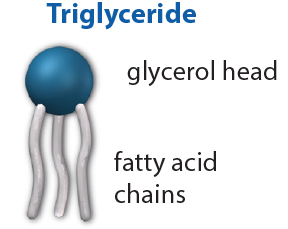Most foods contain a mixture of the three main types of fat. The three main types of fat are saturated, monounsaturated and polyunsaturated.
1. SATURATED FAT
Saturated fatty acids are solid and do not allow for good nutrient flow in and out of cells. Examples of foods high in saturated fat include:
Animal fats
Butter
Coconut oil
Cocoa butter
Palm kernel oil
Partially hydrogenated (trans) fats
2. MONOUNSATURATED FATS
Most of the fats in your diet should be in the monounsaturated form because they are neither too solid (saturated), nor too liquid (polyunsaturated). Examples of foods high in monounsaturated fat include:
Avocado oil
Canola oil
Olive oil
Nuts
3. POLYUNSATURATED FATS
The two subtypes of polyunsaturated fats are the omega-6 and omega-3 fatty acids. These fats are termed essential because the body can not manufacture these fats on their own, and therefore they must be obtained through the diet.
Omega-3 Fats
EPA (eicosapentaenoic acid) and DHA(docosahexenoic acid) are the omega-3 fats found in fish oil. ALA alpha linolenic acid is another type of omega-3 fat found in flax seed oil and walnuts.
Fish oil (EPA & DHA)
Flax seed oil (ALA)
OMEGA -6 FATS
Omega-6 fats are essential, however the typical American Diet is usually overloaded with this type of fat. Examples of foods high in omega-6 fats include:
Corn oil
Soybean oil
Safflower oil
Cottonseed oil
Sunflower oil
OMEGA-6 TO OMEGA-3 RATIO
More important than how much fat you consume is the type of fat you eat. Optimal health is gained from the proper omega-6 to omega-3 ratio and chronic illness is from an imbalance of these two important types of fat. This proves the fact someone can be overweight and healthy, or thin and ill.
Omega-6 fats are pro-inflammatory and omega 3 fats are anti-inflammatory.
Omega-3 fats from fish oil have been shown to delay cancer development and omega-6 fats promote tumor activity.
FAT STORAGE & RELEASE
The fats obtained from food and the fat stored in the human body are mostly in the triglyceride form. Triglycerides contain one glycerol head with three fatty acid chains attached. Triglycerides usually contain a mixture of saturated and polyunsaturated fatty acid chains.

Fat cells can only accept fat in the presence of insulin. Fat cells can not store fat when insulin is low because fat cells have a limited supply of glycerol, which is needed to form a triglyceride (storage fat). Fat can be made from protein, carbohydrates or alcohol. When fats are stored, they remain there for 2-3 weeks.
Most fat is stored between the skin and muscle. Although this body fat looks stagnant, fat cells are in a state of constant turnover. The breakdown and release of fat within fat cells is stimulated by hormones such as epinephrine, norepinephrine, growth hormone, cortisol and thyroid hormone.
Health Benefits of Fat
The heart cells that pump the heart derive most of their energy from fat.
Muscle cells primarily burn fat while at rest or when insulin levels are stabilized.
Fat protects and cushions the organs of the body.
“Sterol” is a type of fat that serves as the precursor to hormones like testosterone, estrogen and cortisol.
The body needs fat for daily maintenance and repair.
The human body can live without carbohydrates, but fat and protein are essential.
HORMONAL EFFECTS OF FAT
Like protein and carbohydrates, fat also acts as a potent hormonal activator within the body. Dietary fat causes the small intestines to release the hormone cholecystokinin (CCK). CCK travels to the brain where it provides you with a feeling of fullness. Feeling satisfied is essential for long term dieting success.
FAT IS FRIENDLY
Do not be afraid of fat. Fat floats aimlessly in the bloodstream and the fate of fat depends on which hormones are dominating the system. If your insulin is high from eating too many carbohydrates, then fat will be stored. As long as you keep your blood sugar stable, then most of your fat will be burned. Your muscles could be fat burning machines as long as they are not being over stimulated by insulin.
High carbohydrate foods are constantly promoted as “fat free” or “low in calories.” This causes the public to subliminally assume there is something wrong with fat. Many people know vegetarians need essential protein but very few people realize fat is as essential for everyone. A person can not have a fat free body unless they get rid of their brain and spinal cord. Calorie counting caused the fear of fat because at 9 calories per gram, fat calories can add up. Weight Watchers would say fat is high in “points.”
According to the Core Fat Loss plan, the fact dietary fat has 9 calories per gram is a positive attribute. Fat is 50% more efficient at producing energy (ATP) compared to carbohydrate, and thus provides a great source of immediate fuel. The metabolism or storage of fat is not up to the fat, but up to the hormonal status of the body. If someone eats too many carbohydrates, insulin will cause fat storage and block fat metabolism. In fact, insulin is the only known fat storing hormone. Fat innocently floats through the bloodstream and muscles readily burn fat even while at rest (and as long as insulin is not dominating the system).